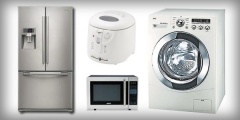Difference between revisions of "Household appliances, white goods"
(Created page with "{{Infobox_Miscellaneous | image = Homehold_appliance,_white_goods.jpg | origin = | stowage factor ...") |
|||
| Line 1: | Line 1: | ||
{{Infobox_Miscellaneous | {{Infobox_Miscellaneous | ||
| image = Homehold_appliance,_white_goods.jpg | | image = Homehold_appliance,_white_goods.jpg | ||
| − | | origin = | + | | origin = - |
| − | | stowage factor = | + | | stowage factor = - |
| − | | humidity and moisture = | + | | humidity and moisture = - |
| − | | ventilation = | + | | ventilation = - |
| − | | risk factors = | + | | risk factors = See text |
}} | }} | ||
| + | ==Description / Application== | ||
| + | A major appliance, or domestic appliance, is usually defined as a large machine which accomplishes some routine housekeeping task, which includes purposes such as cooking, or food preservation, whether in a household, institutional, commercial or industrial setting. An appliance is differentiated from a plumbing fixture because it uses an energy [[input]] for its operation other than water, generally using electricity or natural gas/propane. An object run by a watermill would also be considered an appliance. The term white goods or whiteware is also used for these items, primarily where British English is spoken, although definitions for the term "white goods" can differ. In the United States, the term white goods more commonly refers to linens rather than appliances.<br><br> | ||
| + | Major appliances have become more technically complex from the control side recently with the introduction of the various Energy Labelling rules across the world. This has meant that the appliances have been forced to become more and more efficient leading to more accurate controllers in order to meet the regulations.<br><br> | ||
| + | Major appliances are differentiated from small appliances because they are large, difficult to move, and generally fixed in place to some extent. They are often considered fixtures and part of real estate and as such they are often supplied to tenants as part of otherwise unfurnished rental properties. Another frequent characteristic of major appliances is that they may have substantial electricity requirements that necessitate special electrical wiring to supply higher current and/or voltage than standard electrical outlets can deliver. This limits where they can be placed in a home.<br><br> | ||
| + | <b>Refrigeration equipment</b><br> | ||
| + | * Freezer | ||
| + | * Refrigerator<br> | ||
| + | <b>Stoves</b> | ||
| + | * Cooker, also known as range, stove, oven, cooking plate, or cooktop | ||
| + | * Microwave oven | ||
| + | * Washing equipment | ||
| + | * Washing machine | ||
| + | * Clothes dryer | ||
| + | * Drying cabinet | ||
| + | * Dishwasher<br> | ||
| + | <b>Miscellaneous</b><br> | ||
| + | * Air conditioner | ||
| + | * Water heater | ||
| + | * Computer | ||
| + | * Television | ||
Revision as of 13:25, 27 June 2013
| Infobox on Household appliances, white goods | |
|---|---|
| Example of Household appliances, white goods |  |
| Facts | |
| Origin | - |
| Stowage factor (in m3/t) | - |
| Humidity / moisture | - |
| Ventilation | - |
| Risk factors | See text |
Household appliances, white goods
Description / Application
A major appliance, or domestic appliance, is usually defined as a large machine which accomplishes some routine housekeeping task, which includes purposes such as cooking, or food preservation, whether in a household, institutional, commercial or industrial setting. An appliance is differentiated from a plumbing fixture because it uses an energy input for its operation other than water, generally using electricity or natural gas/propane. An object run by a watermill would also be considered an appliance. The term white goods or whiteware is also used for these items, primarily where British English is spoken, although definitions for the term "white goods" can differ. In the United States, the term white goods more commonly refers to linens rather than appliances.
Major appliances have become more technically complex from the control side recently with the introduction of the various Energy Labelling rules across the world. This has meant that the appliances have been forced to become more and more efficient leading to more accurate controllers in order to meet the regulations.
Major appliances are differentiated from small appliances because they are large, difficult to move, and generally fixed in place to some extent. They are often considered fixtures and part of real estate and as such they are often supplied to tenants as part of otherwise unfurnished rental properties. Another frequent characteristic of major appliances is that they may have substantial electricity requirements that necessitate special electrical wiring to supply higher current and/or voltage than standard electrical outlets can deliver. This limits where they can be placed in a home.
Refrigeration equipment
- Freezer
- Refrigerator
Stoves
- Cooker, also known as range, stove, oven, cooking plate, or cooktop
- Microwave oven
- Washing equipment
- Washing machine
- Clothes dryer
- Drying cabinet
- Dishwasher
Miscellaneous
- Air conditioner
- Water heater
- Computer
- Television











